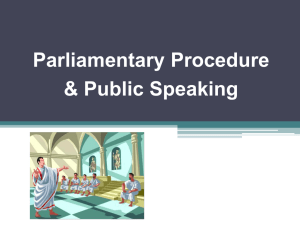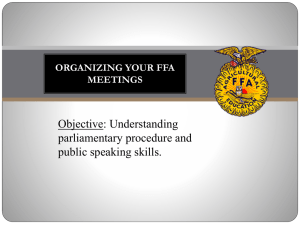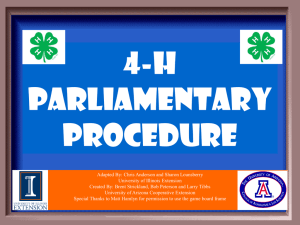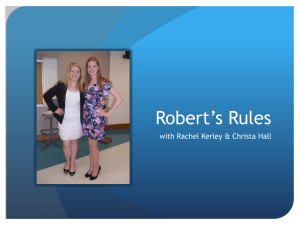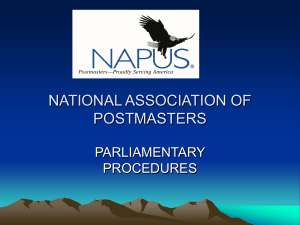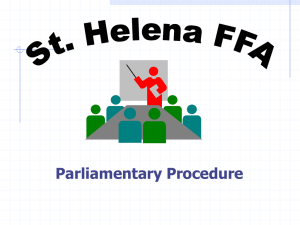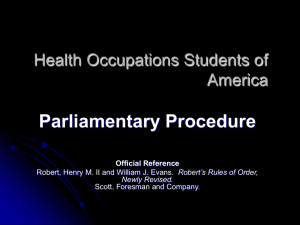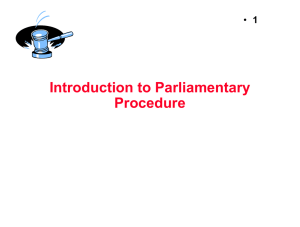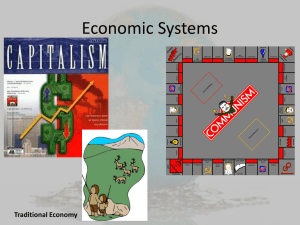Parliamentary Procedure in Agriculture Engineering
advertisement
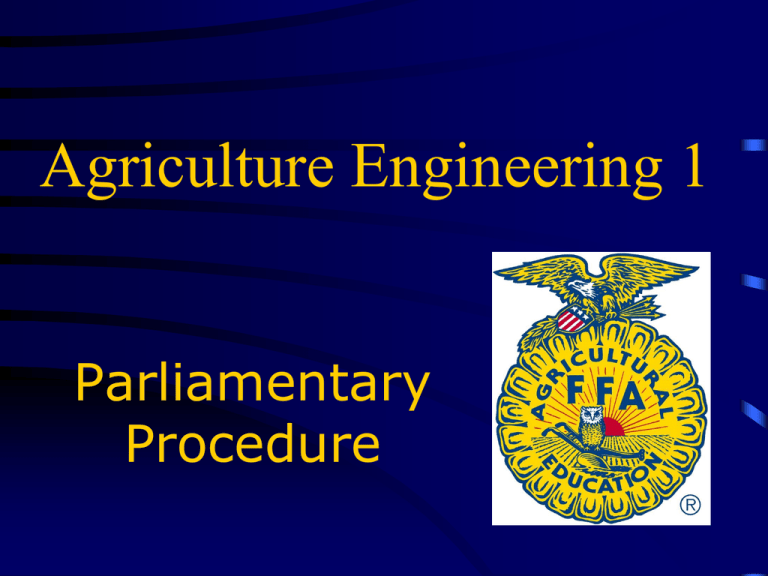
Agriculture Engineering 1 Parliamentary Procedure Conducting a Business Meeting Objective: Analyze the role of Robert’s Rules of Order in conducting a business meeting Conducting A Business Meeting • Objective: Demonstrate key parliamentary abilities that would be used in a business meeting. What is Parliamentary Procedure? Parliamentary procedure is using well defined rules to conduct business using a formal, organized approach. Parliamentary procedure is governed by Robert’s Rules of Order. Parliamentary Law • Robert’s Rule of Order –Rules for conducting a meeting –Assures that all sides are treated fairly and that everyone has the opportunity to discuss and vote Parliamentary Law • Main Objective: –Focus on one item at a time –Extend courtesy to everyone –Observe the rule of the majority –Ensure the rights of the minority Methods of Voting • Voice- aye (pronounced “I”) for yes and “no” • Rising- standing or show of hands • Secret Ballot- written vote • Roll Call- secretary asks each member to state vote Voting • Single majority –one vote more than 50% of the votes cast • Two-thirds majority –2/3 of the members voting toward one side of the motion –usually used when the rights of the members are limited Voting • Quorum –number of members required to conduct business The Gavel • The president uses the gavel to control aspects of the meeting. • The number of taps determines the meaning. Gavel • Symbol of authority • Meaning of the taps – 1 tap means to be seated – 2 taps means the meeting is called to order – 3 taps means that members should stand – Series of taps •“be quite and orderly” What to do? • An Agenda is a list of what will be done at the meeting • Also can be called an Order of Business Presiding Officer • Chapter FFA President • Must be fair and impartial • Must relinquish the chair to the next person in charge to voice their opinion. Motions Main Motion • Used to get group approval for a new project or some other course of action • Wording: “I move” NOT “I make a motion” • Can only have ONE main motion on the table at one time Main Motion • Requires second • Debatable • Amendable • Majority vote required • Can be reconsidered Main Motion Examples • I move to sell fruit this year. • I move that the chapter attends FFA Camp. • I move that we go to the state fair. • I move to raise pigs. Second • A second guarantees that more than one person wants to discuss something in a meeting. • Person making a second doesn’t have to be formally recognized. Amendments • Used to change a main motion • 3 ways to amend: addition, substitution, striking out • Wording: “I move to amend the motion by adding, striking or substituting the words ___________________ for _____________________” Amendments • Requires second • Debatable • Amendable • Majority vote required • Can be reconsidered Amendments Examples • Jim moved to sell fruit to raise money for FFA. Michelle wants to sell flowers. How would she change the motion? Answer: “I move to amend the motion by substituting the word FLOWERS for FRUIT” Adjourn • Used to end a meeting • Wording: “I move to adjourn” Adjourn • Cannot be debated • Cannot be amended • Cannot be reconsidered • Requires second • Requires majority vote Point of Order • Used when one believes a parliamentary error has been made • Wording: “I rise to a point of order” Point of order • Not debatable • Amendable • Does not require second • Cannot be reconsidered • No vote required Division of the House • Calls for a counted vote • Wording: “I call for a division of the house.” Division of the House • Not debatable • Amendable • Does not require second • Cannot be reconsidered • No vote required Lay on the table • To Postpone a motion to the next meeting • Motion must be taken from the table at the next meeting to be discussed • Wording: “I move to lay this motion on the table until _______________” Lay on the table • • • • Requires second Not debatable Not amendable Cannot be reconsidered • Majority vote Previous question • Used to stop debate and vote • Wording: “I move to previous question” Previous question • Second required • Not debatable • Not amendable • Can be reconsidered before vote • 2/3 vote required Refer to committee • Used to gain more information on a motion before voting • Wording: “I move to refer this motion to a committee to report at our next meeting.” Refer to committee • • • • Second required Debatable Amendable Can be reconsidered • Majority vote
